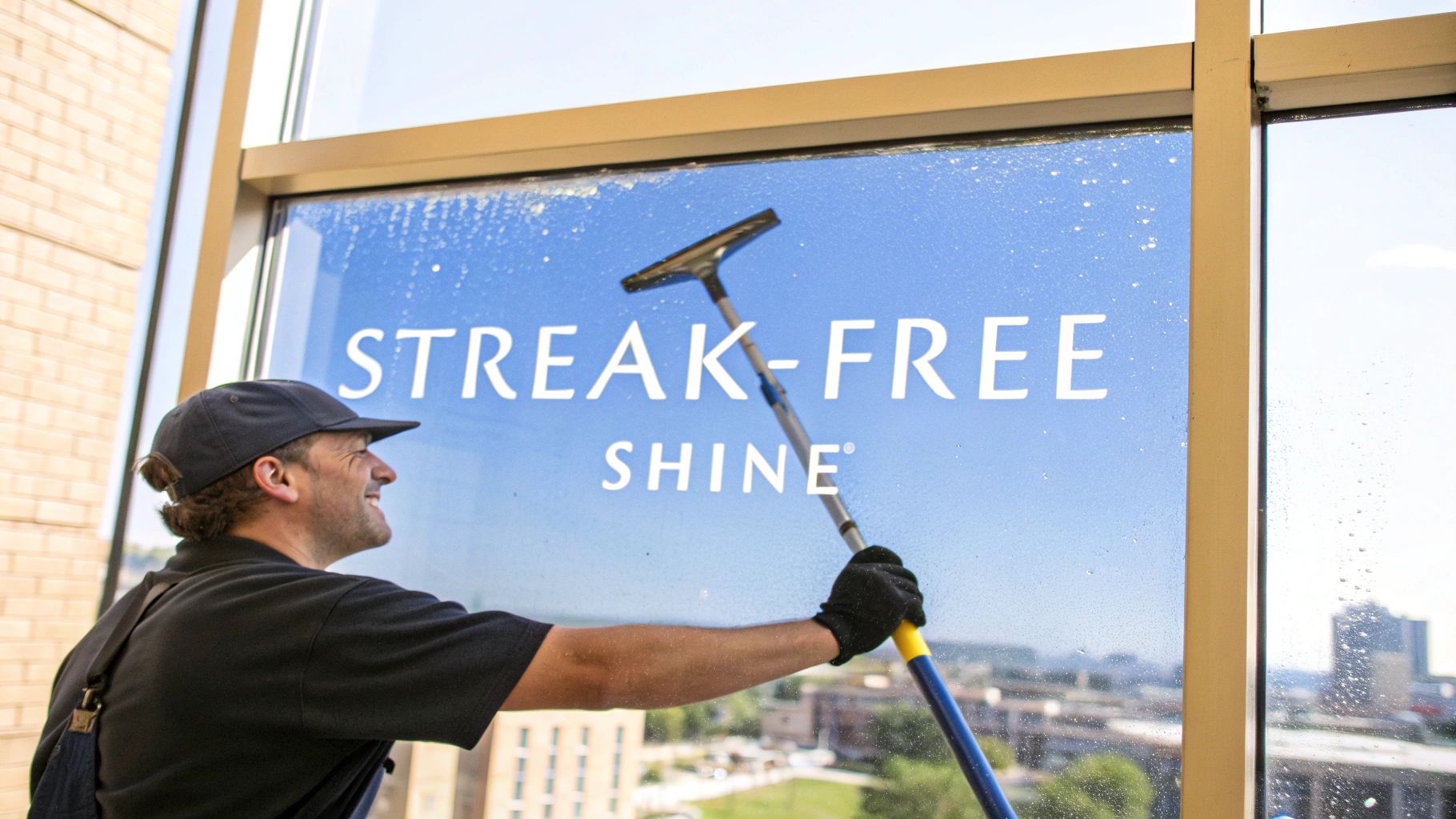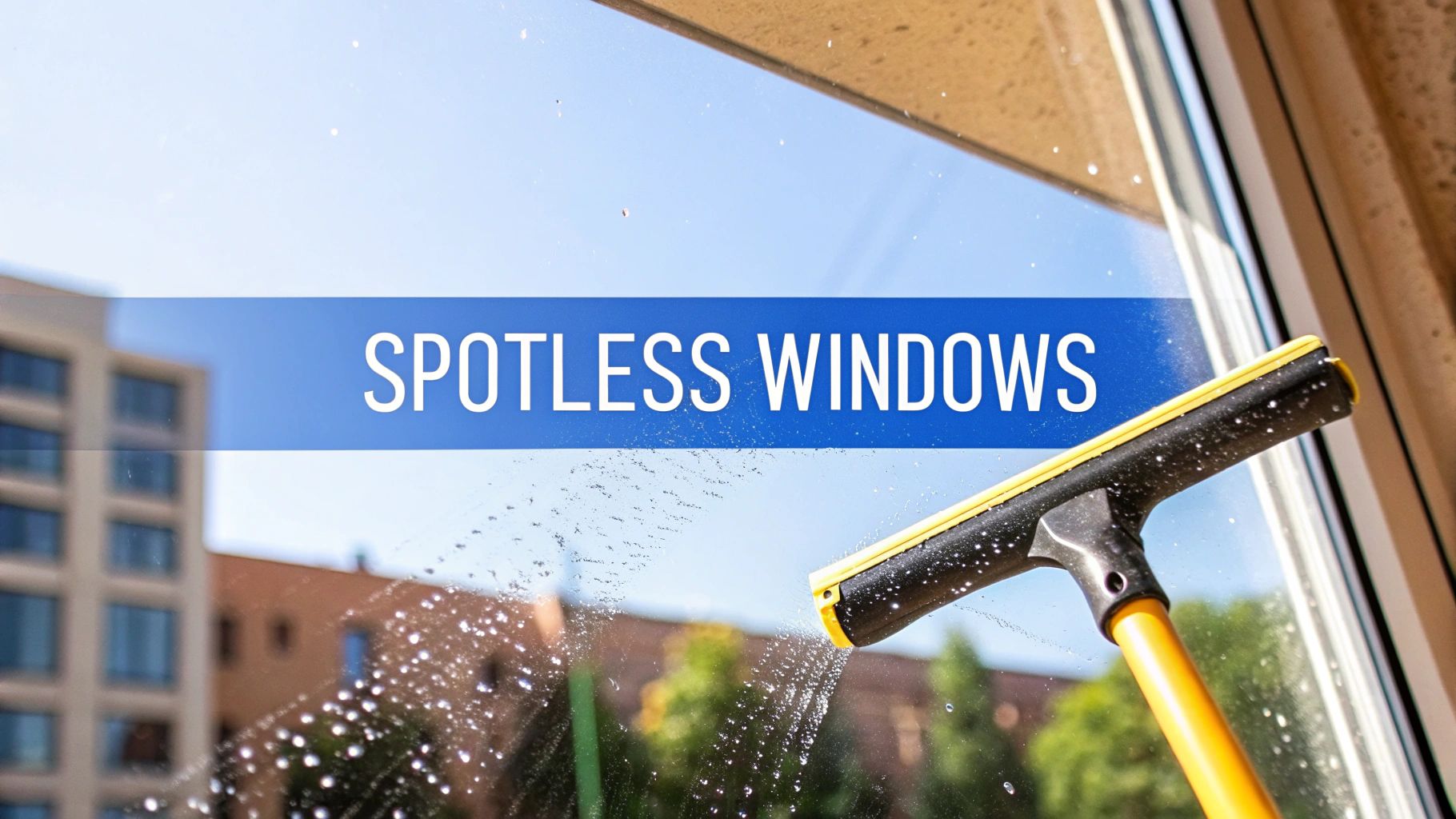hard water stains on windows removal how to: Quick Fix

Getting rid of hard water stains is actually pretty simple once you know what you’re up against. The goal is to dissolve the chalky mineral buildup with a mild acid, like vinegar for light spots, or a heavy-duty commercial cleaner for the really stubborn stuff. After that, it’s all about physically wiping away the residue.
Understanding What Causes Hard Water Stains
Before jumping into solutions, let's talk about what's actually causing those frustrating, milky-white spots on your windows. They aren't just dirt—they're mineral deposits left behind when water evaporates. This is a super common problem if your sprinklers constantly douse your windows or if you have a lot of runoff hitting the glass.
But it’s more than just a surface-level annoyance. The real culprits are high levels of calcium and magnesium carbonate, which are everywhere in hard water. When a water droplet dries on the glass, these minerals get left behind and start to chemically bond with the silica in the glass itself.
From Simple Spots to Permanent Damage
If you ignore it, that bonding process can lead to permanent damage. What starts as a faint, hazy film can morph into thick, crusty deposits that are a nightmare to remove. In the worst-case scenarios, the minerals cause etching—tiny pits and corrosion on the glass surface that you can't just scrub away.
This is why your standard bottle of Windex doesn't even make a dent. Most glass cleaners are designed to tackle dirt and grime, not dissolve hardened mineral compounds. For anyone living in areas with notoriously hard water, like folks in Las Vegas, getting a handle on this science is the first step to getting your windows clear again.
Identifying Stain Severity
Figuring out how bad the stain is will tell you exactly where to start. Hard water stains come in stages, from a light haze to what looks like a permanent fixture on your window. As experts often point out, the cleaning method should match the severity—you start with gentle creams and powders before escalating to stronger acids for tougher jobs. You can find more professional insights on this tiered approach over at JRacenstein.com.
This decision tree gives you a visual guide for sizing up the problem, from a light stain all the way to permanent etching.

The image makes it pretty clear: the longer you wait, the more embedded the stains become, eventually leading to permanent damage that only a professional can handle. The key is to act fast.
To help you figure out the best place to begin, here’s a quick reference table.
Stain Severity and Recommended Starting Point
Use this table to quickly assess your window stains and find the most effective removal method discussed in this guide.
Tackling the problem early gives you the best shot at restoring your window's clarity without needing to pull out the heavy artillery. This guide will walk you through the right solutions for each stage, from simple DIY pastes to powerful commercial cleaners, so you can choose your method with confidence.
When you first spot those faint, chalky marks on your windows, it's tempting to grab the strongest chemical cleaner you can find. But hold on. For fresh or light hard water stains, the best solution is probably already in your kitchen pantry.
Getting to these spots early with a gentle, natural approach is not only effective but also much safer for your windows, your family, and the environment.
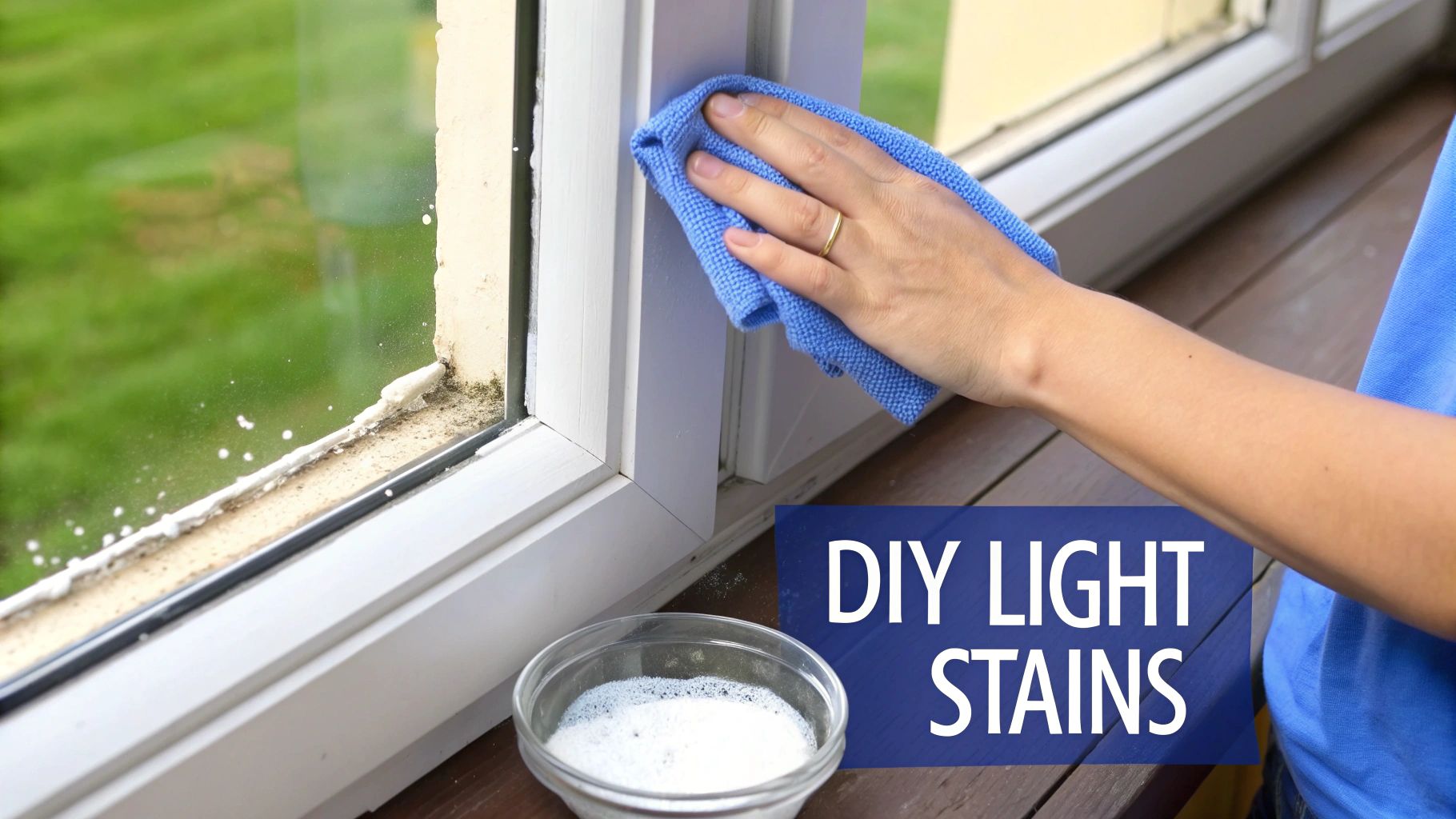
The science here is pretty simple. Hard water minerals like calcium are alkaline, so you need a mild acid to dissolve them. This is where everyday household items really prove their worth, giving you a powerful yet safe way to handle hard water stains on windows removal how to do it right.
The Vinegar Solution: A Go-To Method
White vinegar is the undisputed champion for DIY hard water stain removal. Its acetic acid is just strong enough to break down mineral deposits without being harsh enough to damage standard glass. It's perfect for things like sprinkler overspray on a ground-floor window.
Here’s a technique we often recommend as a starting point:
- Mix Your Solution: Combine equal parts plain white vinegar and distilled water in a spray bottle. Using distilled water is crucial—tap water will just add more minerals to the glass.
- Saturate the Glass: Spray the solution generously over the stained areas. Don't hold back; you want the glass to be completely wet.
- Let It Dwell: This is the most important part. Let the solution sit on the glass for at least 10-15 minutes. This "dwell time" gives the vinegar the time it needs to work its magic and dissolve that mineral buildup.
Once the solution has had a chance to sit, grab a clean, lint-free microfiber cloth and wipe the window clean.
Creating a Baking Soda Paste for Extra Power
Sometimes, vinegar alone won't cut it for those slightly more stubborn spots. If you need a bit more scrubbing power without scratching the glass, baking soda is your best friend. It’s a very mild abrasive that helps physically lift the mineral residue.
Just mix baking soda with a small amount of water to form a paste about the consistency of toothpaste. Apply it directly to the stains and scrub gently in a circular motion with a non-abrasive sponge or microfiber cloth. The combination of light abrasion and chemical reaction can often lift what a simple spray leaves behind.
Important Tip: Never let your vinegar solution or baking soda paste dry on the window. If it starts drying out, just re-spray it with the vinegar solution to keep it damp. A dried-on cleaning agent can leave its own residue, creating more work for you.
Common Mistakes to Avoid
These DIY methods are fantastic, but a few common missteps can lead to frustration or even damage.
- Using the Wrong Cloth: Stay away from paper towels or old, rough rags. They can leave lint behind or, even worse, cause tiny scratches on the glass. Always stick with a quality microfiber cloth.
- Scrubbing Too Hard: Let the chemistry do the heavy lifting. Applying too much force, especially with a dry cloth, can grind the dissolved minerals right back into the glass and cause permanent scratches.
- Working in Direct Sunlight: Cleaning windows on a hot, sunny day is a recipe for failure. The heat will make your cleaning solution evaporate almost instantly, well before it can dissolve the stains. Always try to work in the shade or on an overcast day for the best results.
Before you jump to stronger products, it's worth exploring all your options. For more ideas, you can check out these general strategies for removing water stains from various surfaces, including glass. These simple pantry remedies are surprisingly effective, and mastering them is the first step toward keeping your windows crystal clear.
Tackling Tough Stains with Commercial Products
When your homemade vinegar solution just isn’t cutting it against those stubborn mineral deposits, it’s time to bring in the heavy hitters. DIY methods are fantastic for light, fresh stains, but for layers of buildup that have been sitting for months or even years, you’ll need the focused power of a commercial product.
These formulas are specifically engineered to dissolve the tough calcium and magnesium compounds that have bonded to your glass. They go far beyond the gentle acidity of vinegar, offering more potent solutions that can save you a ton of time and elbow grease.
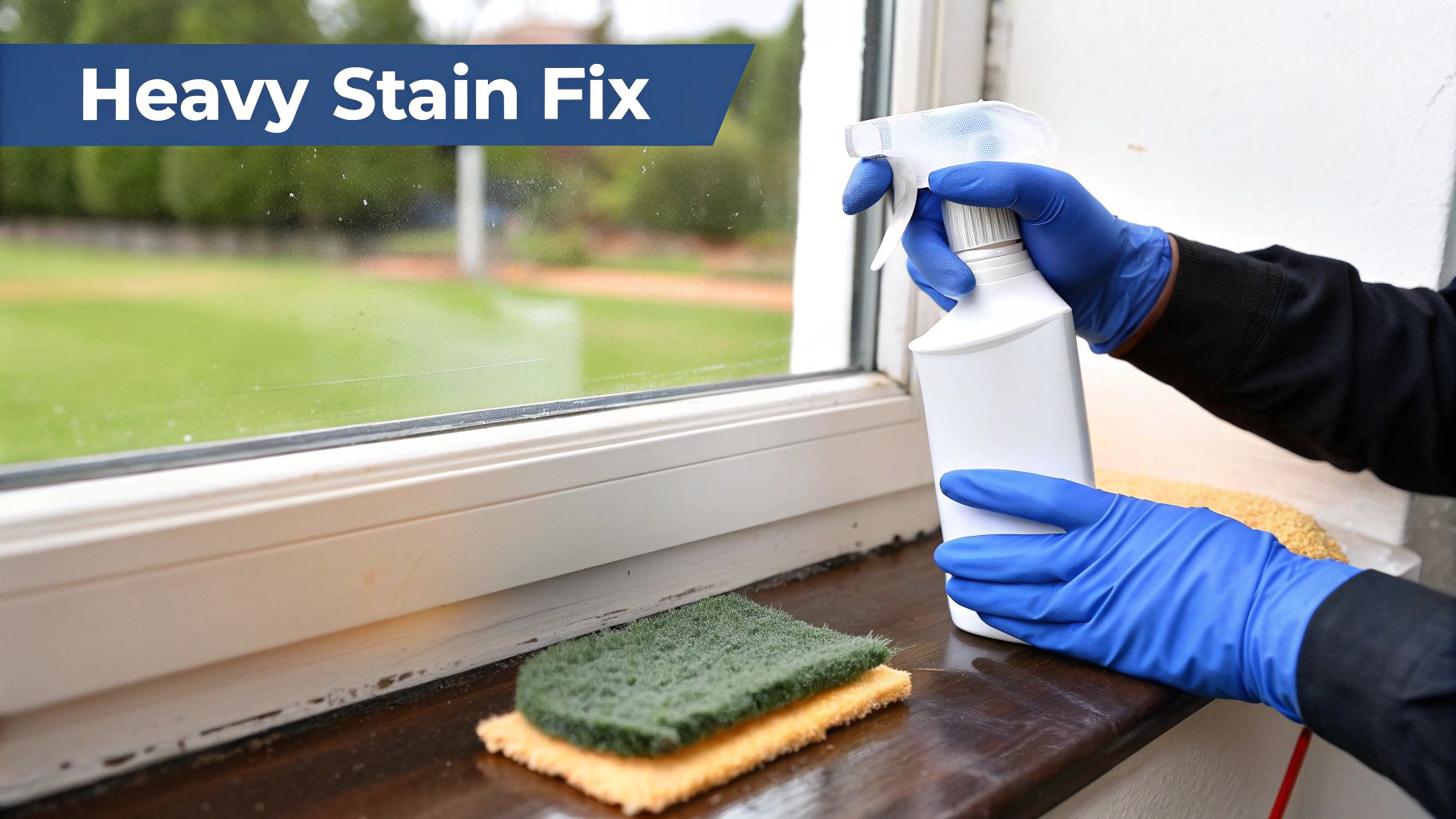
Choosing the Right Commercial Cleaner
Walking down the cleaning aisle can feel overwhelming. To make it simple, commercial hard water removers generally fall into a few key categories. Knowing the difference is crucial for picking the right tool for the job without accidentally causing damage.
- Mild Acid-Based Cleaners: Think of these as the next step up from vinegar. They usually contain gentle acids like citric or phosphoric acid that are really effective at dissolving mineral spots. They’re a great middle-ground option for moderate stains.
- Abrasive Powders and Creams: For more severe, crusty buildup, a product with a fine abrasive gives you the mechanical scrubbing power you need. These work almost like a targeted polish for your glass.
- Chemical Creams: These are thicker formulas that cling to vertical surfaces, giving the active ingredients more time to work. They combine strong chemical action with a mild abrasive quality.
Before you buy, always read the label to make sure it’s safe for glass and follow the manufacturer’s directions to the letter. Some powerful cleaners can damage window frames or surrounding paint if you’re not careful.
Safety First: Essential Precautions
Before you even think about opening a commercial cleaner, you need to get your safety gear in order. These are much stronger chemicals than what’s in your pantry, and you need to handle them with respect.
Crucial Safety Note: Always work in a well-ventilated area to avoid breathing in fumes. Open other windows or set up a fan to keep fresh air moving. Protective gear is absolutely non-negotiable—wear waterproof gloves to protect your skin and safety glasses to shield your eyes from any splashes.
How to Apply Commercial Products Effectively
Once you’re geared up, the application process is pretty straightforward, but the details matter.
First, apply a small amount of the cleaner onto a non-scratch pad or microfiber cloth—not directly onto the glass. This gives you more control and stops the product from running down the window before you can work it in.
Work the product into the stained area using small, firm, circular motions. You want to apply consistent pressure, but don’t try to force it. Let the product’s chemistry and fine abrasives do the heavy lifting. For really tough spots, you might need to reapply the product a second time.
The Professional's Approach to Mechanical Removal
Sometimes, even the best chemical cleaners need a little backup. For the most extreme cases of hard water buildup, we pros often turn to mechanical abrasion to physically lift the mineral deposits off the glass. This is an advanced technique, and it requires a delicate touch.
One of our go-to tools for this is #0000 (super-fine) grade steel wool. It's critical that you use only this grade; anything coarser will absolutely scratch the glass. When you pair it with a cleaning solution as a lubricant, the steel wool can gently shave away the mineral crust without harming the window itself.
But this method isn't for every window. Never use steel wool or any abrasive pad on tinted, coated, or specialty glass, as it will cause permanent, irreversible damage. If you’re not sure what kind of glass you have, it's always best to test on a tiny, hidden corner first or just call a professional.
Pros have a deep understanding of which tools and techniques are right for different types of glass and stain severities. To get a better look inside our toolkit, check out our detailed guide on what professional window cleaners use. That expertise is what ensures the job gets done safely and effectively, especially when we’re dealing with delicate or heavily damaged windows.
Why Some Hard Water Stains Become Permanent
Have you ever scrubbed and scraped at a chalky, stubborn spot on your window, only to have it laugh in your face? It feels like a simple stain, but you’re actually up against a much tougher opponent: glass etching. This is the frustrating reality of what happens when hard water sits on glass for way too long.
Understanding what’s happening at a microscopic level is the key to knowing how to tackle these stains—and, more importantly, how to stop them from ever happening. It's not just a film of minerals on the glass; it's a chemical reaction that’s permanently changing the glass itself.
The Science Behind the Damage
Glass feels perfectly smooth, right? But on a microscopic level, it’s actually porous. It has tiny imperfections and a chemical structure that isn't invincible. The minerals in hard water, mainly calcium and magnesium, are highly alkaline. When a water droplet evaporates, it leaves these mineral deposits behind, and they immediately start a slow, relentless chemical attack on the silica in your window.
Over months, or even years, this constant alkaline assault actually corrodes the glass. It carves out microscopic pits, grooves, and flaws into the surface. That damage is what we call etching. Once it sets in, no amount of traditional window cleaning will ever bring back that factory-fresh clarity. The stain has literally become part of the glass.
Time Is Not on Your Side
The single biggest factor that turns a removable spot into permanent damage is time. A fresh hard water stain from yesterday’s sprinkler mishap is a quick fix. But a stain that’s been baked onto the glass by the sun all summer long? That’s a whole different animal. And one that’s been there for years might be a lost cause.
Talk to any seasoned pro, and they'll tell you the same thing. In professional window cleaning forums, you'll find countless stories of experts battling deeply etched glass. The consensus is that stains left for several years—especially those over four years old—are nearly impossible to remove completely. The glass is just too porous, and the minerals have embedded themselves so deeply into its structure that they can't be pulled out. You can dive deeper into these tough cases by checking out discussions from seasoned window cleaning professionals.
When a professional window cleaner tells you a stain is permanent, they aren’t trying to sell you something extra. They're telling you the glass itself has been physically altered by a chemical reaction, and their squeegee and pure-water system simply can't reverse that kind of damage.
Setting Realistic Expectations for Older Stains
So, what does this all mean for those heavily stained windows you’ve been ignoring? It means you have to be realistic. If your windows have severe, long-standing hard water damage, even the most aggressive commercial products might only get you partial improvement. They can strip away the surface-level mineral deposits—which will definitely make things look better—but they can't fill in the microscopic pits etched into the glass.
From a distance, the window will look much clearer. But get up close, and you’ll likely still see a faint cloudiness or a "ghosting" effect where the permanent damage remains. This is exactly why being proactive is the only guaranteed solution. The best way to deal with glass etching is to never let it happen in the first place.
Let's be honest. While DIY tricks and store-bought sprays can handle minor hard water spots, there's a point where you need to know when to fold 'em. Pushing too hard can do more harm than good, turning a simple cleaning job into a costly window replacement.
Knowing when to step back and call a professional is a critical part of tackling hard water stains. It saves you from frustration, wasted money on products that don't work, and the very real risk of permanently damaging your glass. Sometimes, a job is just too big, too high up, or too far gone for a homeowner to handle safely. An expert brings specialized tools, years of experience, and techniques that just aren't available to the average person.
When Safety Becomes a Concern
This is the big one. If cleaning a window involves more than standing firmly on the ground, it’s time to pause. Stains on second-story windows, skylights, or any glass that forces you onto a ladder introduce a serious risk of falling.
Professional window cleaners are trained, insured, and come equipped with the right safety gear to work at heights without issue. It's just not worth the risk to do it yourself.
Think about these common scenarios where calling a pro is the only smart move:
- Second-Story Windows: Juggling cleaning supplies on a tall ladder is a recipe for disaster.
- High-Rise Buildings: This isn't just window cleaning; it's a specialized trade requiring complex rigging and certifications.
- Awkward Spots: Windows over sloped roofs or uneven landscaping make for unstable ladder placements, dramatically increasing the danger.
When the Glass Is Heavily Etched
We've talked about how severe, long-term hard water buildup can actually eat into the glass. This is called etching, and it leaves the surface looking cloudy, pitted, and rough to the touch. Once it reaches this stage, no amount of scrubbing or vinegar is going to fix it.
At this point, you're not just cleaning—you're restoring. Professionals have access to polishing compounds and specialized buffing tools that can carefully resurface the glass. This delicate process grinds down a microscopic layer to remove the damage, and it takes a skilled hand to avoid creating distortions or weak spots. Trying this yourself will almost certainly ruin the window.
For Delicate and Specialty Glass
Not all glass is the same. Modern homes often feature windows with special coatings or tints that are incredibly easy to damage. Abrasive powders, harsh chemicals, or even fine steel wool can leave permanent scratches on these surfaces, turning into a very expensive mistake.
A professional window cleaner can spot specialty glass like low-E (low-emissivity) coatings or aftermarket tints instantly. They know exactly which products and techniques are safe, protecting your investment while getting the job done right.
Professional Methods Explained
When you hire a pro, you’re paying for mastery of the only two methods they use: a squeegee or a pure-water system. They know that different situations demand different approaches.
- The Traditional Squeegee: In the hands of an expert, nothing beats a squeegee for ground-level windows. They use professional-grade solutions and a precise, practiced technique to lift every bit of dirt and dissolved minerals, leaving a perfectly clear, streak-free finish.
- The Pure-Water System: For higher and hard-to-reach windows, pros use a water-fed pole system. This impressive technology pumps highly filtered, deionized water (often called "pure water") up a pole to a special brush. This ultra-pure water is a natural cleaning powerhouse, pulling minerals and dirt from the glass. Because it contains no dissolved solids, it dries completely spot-free without any need for a squeegee.
For homeowners in hard-water zones like Phoenix, AZ, or those facing stubborn mineral buildup in places like Denver, CO, calling an expert is often the fastest and most effective solution. They have the right tools and deep knowledge to safely cut through years of grime, restoring your view and boosting your home’s curb appeal.
How to Prevent Future Hard Water Buildup
After winning the battle against existing stains, the last thing you want is for them to come right back. Preventing future hard water buildup is all about being proactive, not reactive. The best way to deal with hard water stains is to stop them from ever forming.
That means getting to the root of the problem. If your sprinkler system is the culprit, take a few minutes to adjust the heads. A slight turn can redirect the spray away from your windows, which might be all you need to eliminate the primary source of mineral deposits—zero scrubbing required.
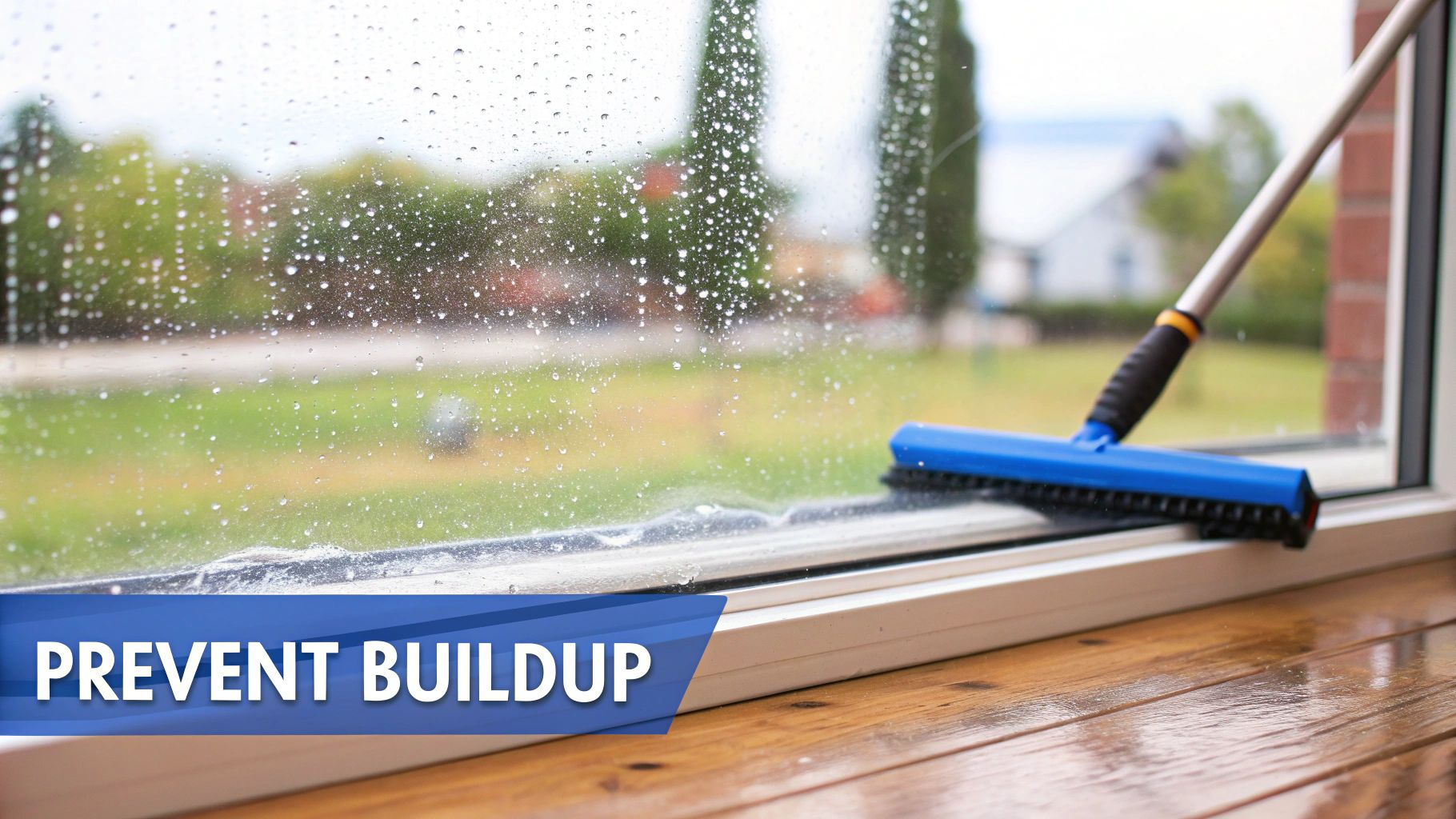
Implement a Simple Maintenance Routine
A little regular upkeep goes a long way. You don’t need to do a deep clean every week, but building a few simple habits into your routine can make a massive difference.
- Squeegee After Exposure: If your windows get soaked by sprinklers or a heavy downpour, a quick pass with a squeegee removes that mineral-heavy water before it has a chance to evaporate and leave spots behind. This simple two-minute task is one of the most effective prevention methods out there.
- Regular Wipedowns: For windows in spots prone to condensation, like a bathroom or kitchen, a quick wipe with a dry microfiber cloth is often enough to stop spots from taking hold.
Of course, mastering the right technique is the key to getting a streak-free finish. We've got a complete walkthrough in our guide on how to squeegee a window like a professional.
Apply a Protective Sealant
For a more hands-off approach, think about applying a hydrophobic glass sealant. These products create an invisible, slick barrier on the glass that makes it hard for water to stick. Instead of clinging to the window, water beads up and rolls right off, taking all those dissolved minerals with it.
Think of it like waxing your car. That protective layer makes it much harder for water and dirt to stick, keeping the surface cleaner for a lot longer. A single application can give you months of protection.
And it's not just about windows—good home maintenance means tackling moisture everywhere. Things like properly maintaining bathroom exhaust fans are crucial for keeping overall humidity in check.
By combining these simple, proactive strategies, you can shift from constantly fighting hard water stains to just enjoying clear, beautiful windows all year. Trust me, a little prevention now is far easier than hours of intense scrubbing later on.
Got Questions? We've Got Answers
When you're dealing with stubborn hard water spots, a few questions always seem to pop up. Here are some quick, no-nonsense answers based on years of experience in the field.
Can I Really Use Steel Wool on My Windows?
Yes, but this is one of those times where the details are everything. You can only use #0000 grade (super-fine) steel wool. It's the only grade soft enough that it won't tear into standard, untreated glass. Anything coarser is a surefire way to leave permanent, ugly scratches.
Even with the right grade, never use it dry. Always work on a wet surface with a good lubricant like soapy water or your cleaning solution. Test it on a small, out-of-the-way spot first, using very light pressure. And just to be clear: this is a hard "no" for any window with tint, coatings, or specialty finishes.
Will These Cleaning Methods Wreck My Window Tint?
Absolutely. It's incredibly easy to damage window tints and modern low-E coatings. These surfaces are far more delicate than raw glass. Abrasive powders, steel wool, or even strong acidic cleaners can strip, scratch, or cause the film to peel away.
For any coated or tinted window, play it safe. Stick with the mildest possible method, like a heavily diluted vinegar solution. Test a tiny corner before you do anything else and forget about aggressive scrubbing. If the stains are severe, your only truly safe option is to call in a professional who knows how to handle specialty glass without ruining it.
How Often Should I Clean to Keep These Stains Away?
Honestly, it all comes down to exposure. If your windows are getting hammered by sprinklers in a place with mineral-heavy water, like Las Vegas, you'll probably need to wipe them down weekly. The goal is to stop the minerals from baking onto the glass in the first place.
For most homes, a deep clean every 3 to 6 months is a good rule of thumb. The real key is just being consistent. Preventing mineral-rich water from drying on the glass is what saves you from a massive cleaning headache later on.
When you're up against tough stains or just can't safely reach your windows, bringing in a pro makes all the difference. Professional Window Cleaning has the right tools and techniques to restore your glass safely and completely. Let us bring back the crystal-clear view you've been missing.
Related articles
Read our blog posts regularly and keep learning.


